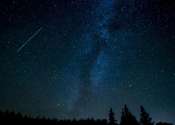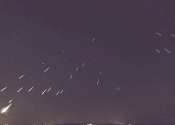Two meteor showers will flash across the sky around the same time in late July
Get ready for a meteor shower doubleheader.

Get ready for a meteor shower doubleheader.
Space Exploration
Jul 29, 2024
0
134

On any clear night, if you gaze skywards long enough, chances are you'll see a meteor streaking through the sky. Some nights, however, are better than others.
Astronomy
Jul 26, 2024
0
64

The next full moon will be Sunday morning, July 21, 2024, appearing opposite the sun (in Earth-based longitude) at 6:17 AM EDT. For the International Date Line West and the American Samoa and Midway time zones this will be ...
Space Exploration
Jul 18, 2024
0
27

Watching meteoroids enter the Earth's atmosphere and streak across the sky as the visual spectacle known as meteors, it is one of the most awe-inspiring spectacles on Earth, often exhibiting multiple colors as they blaze ...
Planetary Sciences
Jun 24, 2024
0
40

The Eta Aquarid meteor shower, remnants of Halley's comet, peaks this weekend. And with just a waning crescent moon in the sky, it should be visible.
Space Exploration
May 3, 2024
1
232

One of the oldest known meteor showers is streaking through the sky above California. The Lyrid meteor shower was first recorded in 687 B.C. and has been studied for more than 2,000 years, according to NASA. The meteor shower ...
Space Exploration
Apr 22, 2024
0
82

The Lyrid meteor shower is underway. But with a nearly full moon in the sky during the peak, it might be tough to see clearly.
Space Exploration
Apr 18, 2024
0
9

Whether you saw the moon completely block the sun, were foiled by cloudy weather or weren't along the path of Monday's total solar eclipse, there are still more chances to catch a glimpse.
Space Exploration
Apr 9, 2024
0
3

The dust of comets fills the space between the planets, collectively called the zodiacal cloud. Still, severe breakdown has reduced that dust in size so much that it now scatters sunlight efficiently, causing the faint glow ...
Astronomy
Mar 21, 2024
0
147

On April 8, 2024, there will be a total solar eclipse in Canada. This is an opportunity to experience, learn from and participate in the excitement and wonder. And rather than hiding inside, researchers have been communicating ...
Planetary Sciences
Mar 14, 2024
0
53
A meteoroid is a sand- to boulder-sized particle of debris in the Solar System. The visible path of a meteoroid that enters Earth's (or another body's) atmosphere is called a meteor, or colloquially a shooting star or falling star. If a meteoroid reaches the ground and survives impact, then it is called a meteorite. Many meteors appearing seconds or minutes apart are called a meteor shower. The root word meteor comes from the Greek meteo¯ros, meaning "high in the air". The Minor Planet Center does not use the term "meteoroid".
This text uses material from Wikipedia, licensed under CC BY-SA